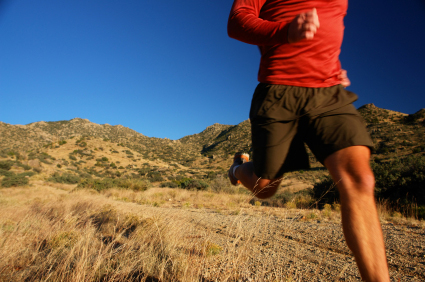
How can I find a running shoe that’s right for my foot?
Your ideal shoe is out there. But before you can find it, you’ll have to figure out your own feet. How are they shaped? If you’re flat-footed, your feet probably roll inward when they hit the ground, a motion called pronation. If you have high, rigid arches, your feet probably roll outward (supination). In either case, you’ll want a shoe that keeps your foot comfortably stable. A little rolling is helpful for absorbing shocks, but too much can be problematic.
One quick way to determine your foot type is to wet the bottom of your foot and step on a paper shopping bag or a blank piece of paper. If you can see almost your entire footprint, you have a flat arch. If you cant see much besides the heel and ball of your foot, you have high arches. Most people have medium arches; they leave a classic footprint that includes the heel, ball, and about half of the arch.
Nearly all running-shoe manufacturers make shoes to accommodate each of the three specific foot types. Once you know your foot type, look for these labels:
- Cushion (for high arches). The extra cushioning in these semi-curved shoes gives support to high arches, absorbs shocks, and helps keep the feet from rolling outward while running.
- Motion control (for flat feet). These shoes have a straighter shape and a more rigid insole to help prevent extreme pronation.
- Stability (for normal feet). The best shoes for normal feet combine a semi-curved shape with a flexible midsole.
How can I make sure my shoes fit properly?
Good running shoes are an investment; you don’t want to rush your choice. Find a store with knowledgeable salespeople and spend some time trying on different pairs. Here are some tips for a good fit:
- Shop late in the day, when your feet are likely to be at their largest.
- Wear the same sort of socks that you run in.
- Don’t get locked into a particular number when choosing a shoe size. Different companies make different sizes, and your running shoe could turn out to be a half-size or full-size larger than your dress shoe.
- You’ll want a heel that fits snugly. A heel that slips up and down when you run is a recipe for blisters.
- Don’t crowd your toes. There should be at least a quarter inch of space between the end of your toes and the end of the shoe, enough for wiggle room.
- The shoes should fit snugly on your arches but shouldn’t feel tight.
- Try jogging in place or taking a few quick strides to see if the shoes feel comfortable. Better yet, see if they’ll let you run around the block.
- Bring along a pair of old running shoes, even if you didn’t especially like them. A good salesperson can tell a lot about your running style and your needs by looking at the wear pattens on your shoe.
How do I know when it’s time to replace my running shoes?
The average running shoe will last 400 miles or so. That means that you’ll need a new pair every four months if your run about 25 miles a week. Keep in mind that the cushioning in a shoe can give out long before the treads show signs of wear. If your shoes no longer feel comfortable or if you’re suffering from shin splints or knee pain, it may be time for a new pair.
By Chris Woolston, M.S.
Exercise and Fitness Health Library Copyright ©2017 LimeHealth. All Rights Reserved.
